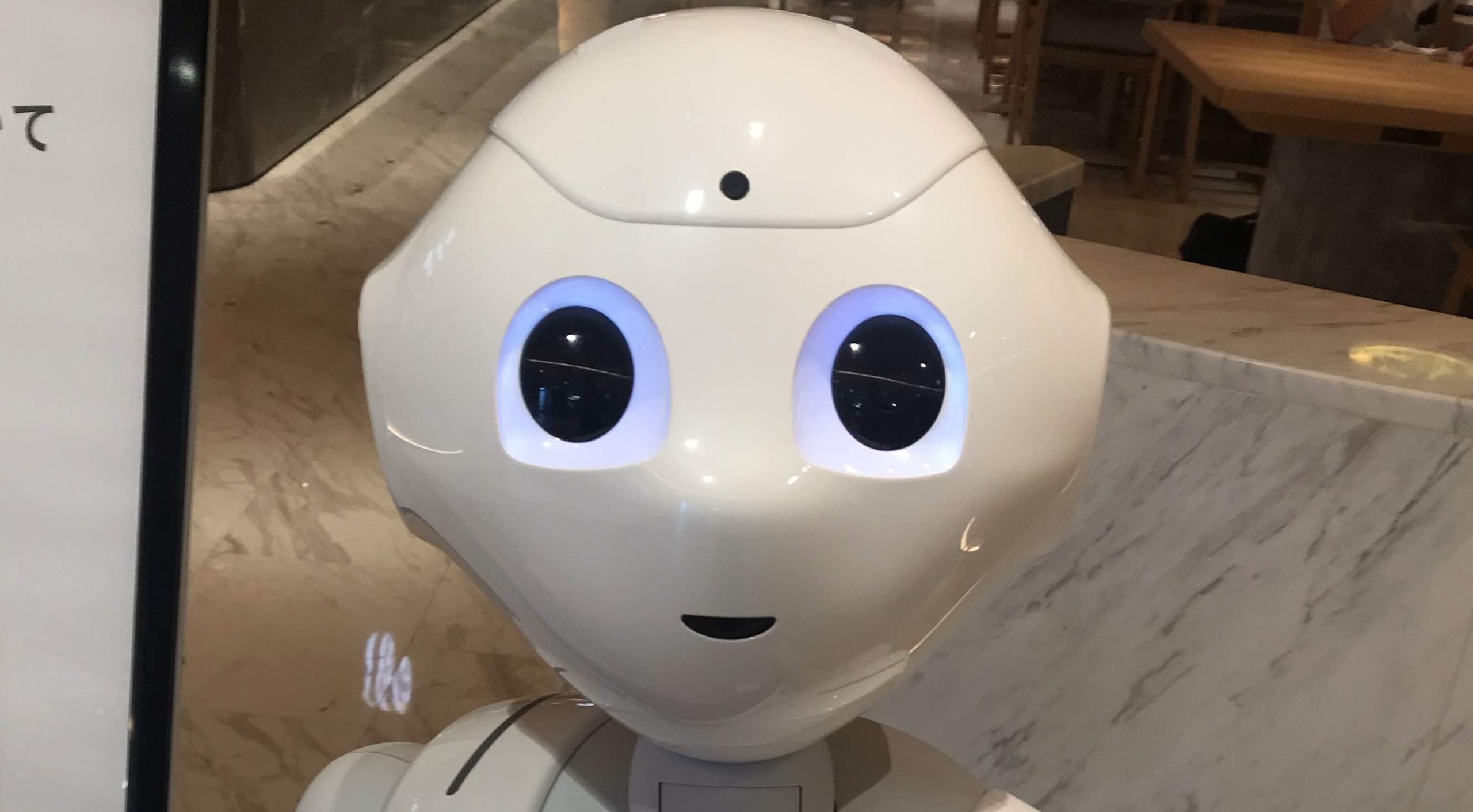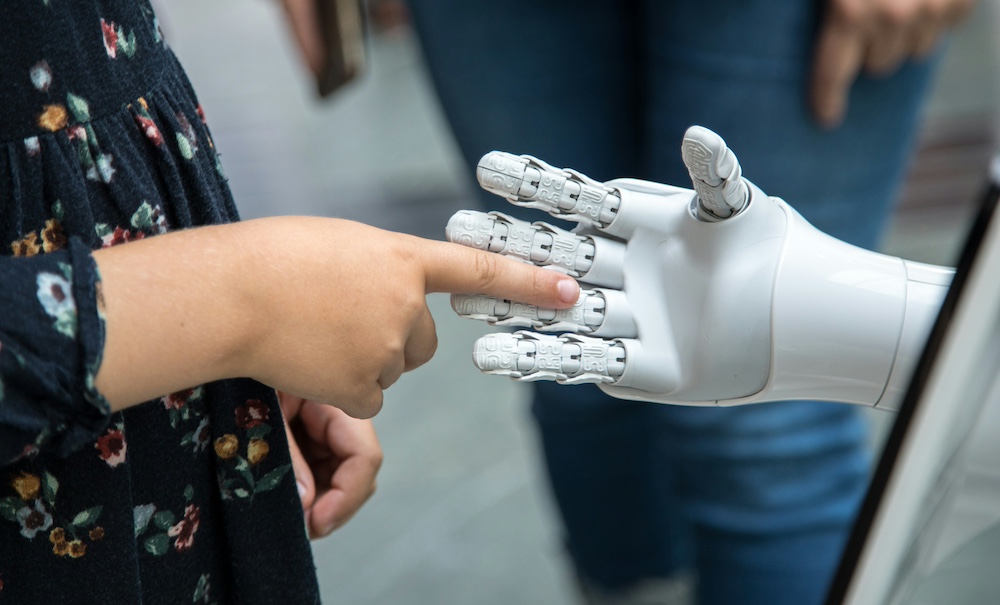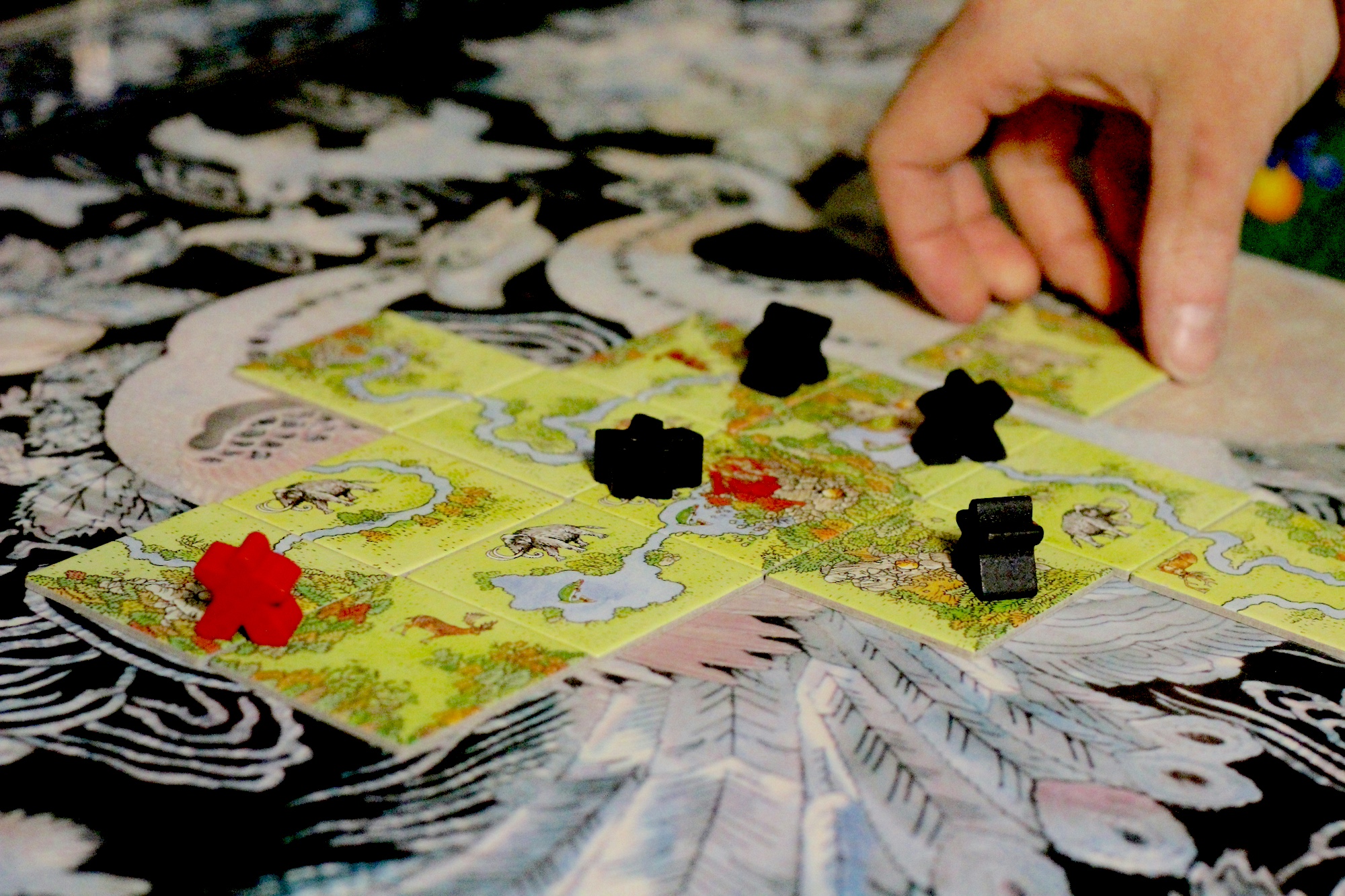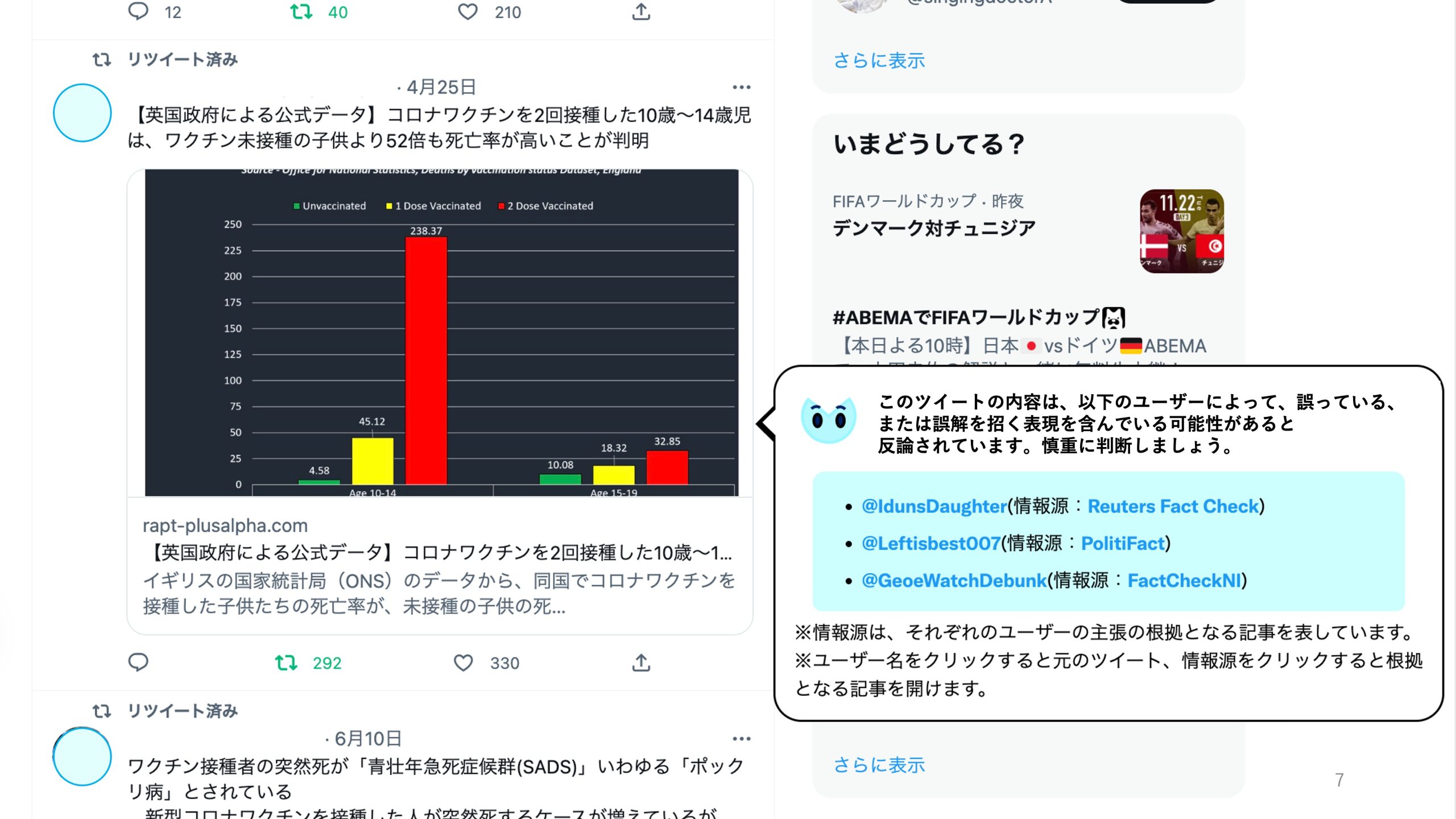Pepper's gender puzzle
Gender/ing guides how we perceive ourselves and the world around us. We reviewed the case of Pepper, a gender-ambiguous humanoid robot.
ジェンダー(化)は、私たち自身や世界、他者をどのように見るかを導く。ジェンダーが曖昧で人間的なロボットであるPepperのケースを批判的にレビューした。
Publication
2909664
{2909664:AXD6BMLS}
1
apa
50
default
1296
https://aspirelab.io/wp-content/plugins/zotpress/
%7B%22status%22%3A%22success%22%2C%22updateneeded%22%3Afalse%2C%22instance%22%3Afalse%2C%22meta%22%3A%7B%22request_last%22%3A0%2C%22request_next%22%3A0%2C%22used_cache%22%3Atrue%7D%2C%22data%22%3A%5B%7B%22key%22%3A%22AXD6BMLS%22%2C%22library%22%3A%7B%22id%22%3A2909664%7D%2C%22meta%22%3A%7B%22creatorSummary%22%3A%22Seaborn%20and%20Frank%22%2C%22parsedDate%22%3A%222022%22%2C%22numChildren%22%3A1%7D%2C%22bib%22%3A%22%26lt%3Bdiv%20class%3D%26quot%3Bcsl-bib-body%26quot%3B%20style%3D%26quot%3Bline-height%3A%202%3B%20padding-left%3A%201em%3B%20text-indent%3A-1em%3B%26quot%3B%26gt%3B%5Cn%20%20%26lt%3Bdiv%20class%3D%26quot%3Bcsl-entry%26quot%3B%26gt%3BSeaborn%2C%20K.%2C%20%26amp%3B%20Frank%2C%20A.%20%282022%29.%20What%20pronouns%20for%20Pepper%3F%20A%20critical%20review%20of%20gender%5C%2Fing%20in%20research.%20%26lt%3Bi%26gt%3BProceedings%20of%20the%202022%20CHI%20Conference%20on%20Human%20Factors%20in%20Computing%20Systems%26lt%3B%5C%2Fi%26gt%3B%2C%201%26%23x2013%3B15.%20%26lt%3Ba%20class%3D%26%23039%3Bzp-ItemURL%26%23039%3B%20href%3D%26%23039%3Bhttps%3A%5C%2F%5C%2Fdoi.org%5C%2F10.1145%5C%2F3491102.3501996%26%23039%3B%26gt%3Bhttps%3A%5C%2F%5C%2Fdoi.org%5C%2F10.1145%5C%2F3491102.3501996%26lt%3B%5C%2Fa%26gt%3B%26lt%3B%5C%2Fdiv%26gt%3B%5Cn%26lt%3B%5C%2Fdiv%26gt%3B%22%2C%22data%22%3A%7B%22itemType%22%3A%22conferencePaper%22%2C%22title%22%3A%22What%20pronouns%20for%20Pepper%3F%20A%20critical%20review%20of%20gender%5C%2Fing%20in%20research%22%2C%22creators%22%3A%5B%7B%22creatorType%22%3A%22author%22%2C%22firstName%22%3A%22Katie%22%2C%22lastName%22%3A%22Seaborn%22%7D%2C%7B%22creatorType%22%3A%22author%22%2C%22firstName%22%3A%22Alexa%22%2C%22lastName%22%3A%22Frank%22%7D%5D%2C%22abstractNote%22%3A%22Gender%5C%2Fing%20guides%20how%20we%20view%20ourselves%2C%20the%20world%20around%20us%2C%20and%20each%20other%5Cu2014including%20non-humans.%20Critical%20voices%20have%20raised%20the%20alarm%20about%20stereotyped%20gendering%20in%20the%20design%20of%20socially%20embodied%20artificial%20agents%20like%20voice%20assistants%2C%20conversational%20agents%2C%20and%20humanoid%20robots.%20Yet%2C%20there%20is%20little%20empirical%20work%20on%20how%20this%20plays%20out%20in%20research%20and%20to%20what%20extent.%20As%20a%20first%20step%2C%20we%20critically%20reviewed%20the%20case%20of%20Pepper%2C%20a%20gender-ambiguous%20humanoid%20robot.%20We%20conducted%20a%20systematic%20review%20%28n%3D75%29%20involving%20meta-synthesis%20and%20content%20analysis%2C%20examining%20how%20participants%20and%20researchers%20gendered%20Pepper%20through%20stated%20and%20unstated%20signifiers%20and%20pronoun%20usage.%20We%20found%20that%20ascriptions%20of%20Pepper%5Cu2019s%20gender%20were%20inconsistent%2C%20limited%2C%20and%20at%20times%20discordant%2C%20with%20little%20evidence%20of%20conscious%20gendering%20and%20some%20indication%20of%20researcher%20influence%20on%20participant%20gendering.%20We%20offer%20six%20challenges%20driving%20the%20state%20of%20affairs%20and%20as%20a%20practical%20framework%20for%20centering%20gender%20in%20research%20on%20socially%20embodied%20artificial%20agents.%22%2C%22proceedingsTitle%22%3A%22Proceedings%20of%20the%202022%20CHI%20Conference%20on%20Human%20Factors%20in%20Computing%20Systems%22%2C%22conferenceName%22%3A%22CHI%20%2722%22%2C%22date%22%3A%222022%22%2C%22DOI%22%3A%2210.1145%5C%2F3491102.3501996%22%2C%22ISBN%22%3A%22978-1-4503-9157-3%22%2C%22citationKey%22%3A%22%22%2C%22url%22%3A%22https%3A%5C%2F%5C%2Fdoi.org%5C%2F10.1145%5C%2F3491102.3501996%22%2C%22ISSN%22%3A%22%22%2C%22language%22%3A%22%22%2C%22collections%22%3A%5B%22T7C48C2U%22%2C%22CT3YBSJN%22%2C%22BWBSBD9V%22%2C%223IZ87LV6%22%5D%2C%22dateModified%22%3A%222025-10-06T03%3A40%3A45Z%22%7D%7D%5D%7D
Seaborn, K., & Frank, A. (2022). What pronouns for Pepper? A critical review of gender/ing in research. Proceedings of the 2022 CHI Conference on Human Factors in Computing Systems, 1–15. https://doi.org/10.1145/3491102.3501996


Gender/ing guides how we perceive ourselves and the world around us. We reviewed the case of Pepper, a gender-ambiguous humanoid robot.
ジェンダー(化)は、私たち自身や世界、他者をどのように見るかを導く。ジェンダーが曖昧で人間的なロボットであるPepperのケースを批判的にレビューした。


Voiceless encounters with robots
Designing robots with nonverbal cues may foster more natural, inviting, and accessible experiences.
非言語的な合図をロボットにデザインすることで、より自然で、魅力的で、親しみやすい体験が生まれるかもしれない。
Theme
Voice UX/音声UX
Publication
2909664
{2909664:7SCCZTGG}
1
apa
50
default
1296
https://aspirelab.io/wp-content/plugins/zotpress/
%7B%22status%22%3A%22success%22%2C%22updateneeded%22%3Afalse%2C%22instance%22%3Afalse%2C%22meta%22%3A%7B%22request_last%22%3A0%2C%22request_next%22%3A0%2C%22used_cache%22%3Atrue%7D%2C%22data%22%3A%5B%7B%22key%22%3A%227SCCZTGG%22%2C%22library%22%3A%7B%22id%22%3A2909664%7D%2C%22meta%22%3A%7B%22lastModifiedByUser%22%3A%7B%22id%22%3A66010%2C%22username%22%3A%22kseaborn%22%2C%22name%22%3A%22Katie%20Seaborn%22%2C%22links%22%3A%7B%22alternate%22%3A%7B%22href%22%3A%22https%3A%5C%2F%5C%2Fwww.zotero.org%5C%2Fkseaborn%22%2C%22type%22%3A%22text%5C%2Fhtml%22%7D%7D%7D%2C%22creatorSummary%22%3A%22Urakami%20and%20Seaborn%22%2C%22parsedDate%22%3A%222023-06-30%22%2C%22numChildren%22%3A1%7D%2C%22bib%22%3A%22%26lt%3Bdiv%20class%3D%26quot%3Bcsl-bib-body%26quot%3B%20style%3D%26quot%3Bline-height%3A%202%3B%20padding-left%3A%201em%3B%20text-indent%3A-1em%3B%26quot%3B%26gt%3B%5Cn%20%20%26lt%3Bdiv%20class%3D%26quot%3Bcsl-entry%26quot%3B%26gt%3BUrakami%2C%20J.%2C%20%26amp%3B%20Seaborn%2C%20K.%20%282023%29.%20Nonverbal%20Cues%20in%20Human%26%23x2013%3BRobot%20Interaction%3A%20A%20Communication%20Studies%20Perspective.%20%26lt%3Bi%26gt%3BACM%20Transactions%20on%20Human-Robot%20Interaction%26lt%3B%5C%2Fi%26gt%3B%2C%20%26lt%3Bi%26gt%3B12%26lt%3B%5C%2Fi%26gt%3B%282%29%2C%201%26%23x2013%3B21.%20%26lt%3Ba%20class%3D%26%23039%3Bzp-DOIURL%26%23039%3B%20href%3D%26%23039%3Bhttps%3A%5C%2F%5C%2Fdoi.org%5C%2F10.1145%5C%2F3570169%26%23039%3B%26gt%3Bhttps%3A%5C%2F%5C%2Fdoi.org%5C%2F10.1145%5C%2F3570169%26lt%3B%5C%2Fa%26gt%3B%26lt%3B%5C%2Fdiv%26gt%3B%5Cn%26lt%3B%5C%2Fdiv%26gt%3B%22%2C%22data%22%3A%7B%22itemType%22%3A%22journalArticle%22%2C%22title%22%3A%22Nonverbal%20Cues%20in%20Human%5Cu2013Robot%20Interaction%3A%20A%20Communication%20Studies%20Perspective%22%2C%22creators%22%3A%5B%7B%22creatorType%22%3A%22author%22%2C%22firstName%22%3A%22Jacqueline%22%2C%22lastName%22%3A%22Urakami%22%7D%2C%7B%22creatorType%22%3A%22author%22%2C%22firstName%22%3A%22Katie%22%2C%22lastName%22%3A%22Seaborn%22%7D%5D%2C%22abstractNote%22%3A%22Communication%20between%20people%20is%20characterized%20by%20a%20broad%20range%20of%20nonverbal%20cues.%20Transferring%20these%20cues%20into%20the%20design%20of%20robots%20and%20other%20artificial%20agents%20that%20interact%20with%20people%20may%20foster%20more%20natural%2C%20inviting%2C%20and%20accessible%20experiences.%20In%20this%20article%2C%20we%20offer%20a%20series%20of%20definitive%20nonverbal%20codes%20for%20human%5Cu2013robot%20interaction%20%28HRI%29%20that%20address%20the%20five%20human%20sensory%20systems%20%28visual%2C%20auditory%2C%20haptic%2C%20olfactory%2C%20and%20gustatory%29%20drawn%20from%20the%20field%20of%20communication%20studies.%20We%20discuss%20how%20these%20codes%20can%20be%20translated%20into%20design%20patterns%20for%20HRI%20using%20a%20curated%20sample%20of%20the%20communication%20studies%20and%20HRI%20literatures.%20As%20nonverbal%20codes%20are%20an%20essential%20mode%20in%20human%20communication%2C%20we%20argue%20that%20integrating%20robotic%20nonverbal%20codes%20in%20HRI%20will%20afford%20robots%20a%20feeling%20of%20%5Cu201caliveness%5Cu201d%20or%20%5Cu201csocial%20agency%5Cu201d%20that%20would%20otherwise%20be%20missing.%20We%20end%20with%20suggestions%20for%20research%20directions%20to%20stimulate%20work%20on%20nonverbal%20communication%20within%20the%20field%20of%20HRI%20and%20improve%20communication%20between%20people%20and%20robots.%22%2C%22date%22%3A%222023-06-30%22%2C%22section%22%3A%22%22%2C%22partNumber%22%3A%22%22%2C%22partTitle%22%3A%22%22%2C%22DOI%22%3A%2210.1145%5C%2F3570169%22%2C%22citationKey%22%3A%22%22%2C%22url%22%3A%22https%3A%5C%2F%5C%2Fdl.acm.org%5C%2Fdoi%5C%2F10.1145%5C%2F3570169%22%2C%22PMID%22%3A%22%22%2C%22PMCID%22%3A%22%22%2C%22ISSN%22%3A%222573-9522%2C%202573-9522%22%2C%22language%22%3A%22en%22%2C%22collections%22%3A%5B%22T7C48C2U%22%2C%22BWBSBD9V%22%2C%22GGM46V8J%22%5D%2C%22dateModified%22%3A%222024-04-07T13%3A33%3A37Z%22%7D%7D%5D%7D
Urakami, J., & Seaborn, K. (2023). Nonverbal Cues in Human–Robot Interaction: A Communication Studies Perspective. ACM Transactions on Human-Robot Interaction, 12(2), 1–21. https://doi.org/10.1145/3570169


Designing robots with nonverbal cues may foster more natural, inviting, and accessible experiences.
非言語的な合図をロボットにデザインすることで、より自然で、魅力的で、親しみやすい体験が生まれるかもしれない。
Theme
Voice UX/音声UX


Deception by design
We unearth dark patterns and deceptive designs (DPs), elements of the user interface that trick people.
ダーク・パターンや欺瞞的なデザイン(DP)は、ユーザ・インターフェイスの要素であり、人々を騙して他の人が取らないような行動を取らせるものである。
Publication
2909664
{2909664:CARXBNJD}
1
apa
50
default
1296
https://aspirelab.io/wp-content/plugins/zotpress/
%7B%22status%22%3A%22success%22%2C%22updateneeded%22%3Afalse%2C%22instance%22%3Afalse%2C%22meta%22%3A%7B%22request_last%22%3A0%2C%22request_next%22%3A0%2C%22used_cache%22%3Atrue%7D%2C%22data%22%3A%5B%7B%22key%22%3A%22CARXBNJD%22%2C%22library%22%3A%7B%22id%22%3A2909664%7D%2C%22meta%22%3A%7B%22creatorSummary%22%3A%22Hidaka%20et%20al.%22%2C%22parsedDate%22%3A%222023-04-23%22%2C%22numChildren%22%3A3%7D%2C%22bib%22%3A%22%26lt%3Bdiv%20class%3D%26quot%3Bcsl-bib-body%26quot%3B%20style%3D%26quot%3Bline-height%3A%202%3B%20padding-left%3A%201em%3B%20text-indent%3A-1em%3B%26quot%3B%26gt%3B%5Cn%20%20%26lt%3Bdiv%20class%3D%26quot%3Bcsl-entry%26quot%3B%26gt%3BHidaka%2C%20S.%2C%20Kobuki%2C%20S.%2C%20Watanabe%2C%20M.%2C%20%26amp%3B%20Seaborn%2C%20K.%20%282023%29.%20Linguistic%20dead-ends%20and%20alphabet%20soup%3A%20Finding%20dark%20patterns%20in%20Japanese%20apps.%20%26lt%3Bi%26gt%3BProceedings%20of%20the%202023%20CHI%20Conference%20on%20Human%20Factors%20in%20Computing%20Systems%26lt%3B%5C%2Fi%26gt%3B%2C%201%26%23x2013%3B13.%20%26lt%3Ba%20class%3D%26%23039%3Bzp-ItemURL%26%23039%3B%20href%3D%26%23039%3Bhttps%3A%5C%2F%5C%2Fdoi.org%5C%2F10.1145%5C%2F3544548.3580942%26%23039%3B%26gt%3Bhttps%3A%5C%2F%5C%2Fdoi.org%5C%2F10.1145%5C%2F3544548.3580942%26lt%3B%5C%2Fa%26gt%3B%26lt%3B%5C%2Fdiv%26gt%3B%5Cn%26lt%3B%5C%2Fdiv%26gt%3B%22%2C%22data%22%3A%7B%22itemType%22%3A%22conferencePaper%22%2C%22title%22%3A%22Linguistic%20dead-ends%20and%20alphabet%20soup%3A%20Finding%20dark%20patterns%20in%20Japanese%20apps%22%2C%22creators%22%3A%5B%7B%22creatorType%22%3A%22author%22%2C%22firstName%22%3A%22Shun%22%2C%22lastName%22%3A%22Hidaka%22%7D%2C%7B%22creatorType%22%3A%22author%22%2C%22firstName%22%3A%22Sota%22%2C%22lastName%22%3A%22Kobuki%22%7D%2C%7B%22creatorType%22%3A%22author%22%2C%22firstName%22%3A%22Mizuki%22%2C%22lastName%22%3A%22Watanabe%22%7D%2C%7B%22creatorType%22%3A%22author%22%2C%22firstName%22%3A%22Katie%22%2C%22lastName%22%3A%22Seaborn%22%7D%5D%2C%22abstractNote%22%3A%22Dark%20patterns%20are%20deceptive%20and%20malicious%20properties%20of%20user%20interfaces%20that%20lead%20the%20end-user%20to%20do%20something%20different%20from%20intended%20or%20expected.%20While%20now%20a%20key%20topic%20in%20critical%20computing%2C%20most%20work%20has%20been%20conducted%20in%20Western%20contexts.%20Japan%2C%20with%20its%20booming%20app%20market%2C%20is%20a%20relatively%20uncharted%20context%20that%20offers%20culturally-%20and%20linguistically-sensitive%20differences%20in%20design%20standards%2C%20contexts%20of%20use%2C%20values%2C%20and%20language%2C%20all%20of%20which%20could%20influence%20the%20presence%20and%20expression%20of%20dark%20patterns.%20In%20this%20work%2C%20we%20analyzed%20200%20popular%20mobile%20apps%20in%20the%20Japanese%20market.%20We%20found%20that%20most%20apps%20had%20dark%20patterns%2C%20with%20an%20average%20of%203.9%20per%20app.%20We%20also%20identified%20a%20new%20class%20of%20dark%20pattern%3A%20%5Cu201cLinguistic%20Dead-Ends%5Cu201d%20in%20the%20forms%20of%20%5Cu201cUntranslation%5Cu201d%20and%20%5Cu201cAlphabet%20Soup.%5Cu201d%20We%20outline%20the%20implications%20for%20design%20and%20research%20practice%2C%20especially%20for%20future%20cross-cultural%20research%20on%20dark%20patterns.%22%2C%22proceedingsTitle%22%3A%22Proceedings%20of%20the%202023%20CHI%20Conference%20on%20Human%20Factors%20in%20Computing%20Systems%22%2C%22conferenceName%22%3A%22CHI%20%2723%22%2C%22date%22%3A%22April%2023-28%2C%202023%22%2C%22DOI%22%3A%2210.1145%5C%2F3544548.3580942%22%2C%22ISBN%22%3A%22978-1-4503-9421-5%22%2C%22citationKey%22%3A%22%22%2C%22url%22%3A%22https%3A%5C%2F%5C%2Fdoi.org%5C%2F10.1145%5C%2F3544548.3580942%22%2C%22ISSN%22%3A%22%22%2C%22language%22%3A%22%22%2C%22collections%22%3A%5B%22T7C48C2U%22%2C%2242NL6UGK%22%2C%22QJHFDRXT%22%2C%22CA8F2K7J%22%2C%2242IMTY79%22%5D%2C%22dateModified%22%3A%222024-10-20T14%3A09%3A32Z%22%7D%7D%5D%7D
Hidaka, S., Kobuki, S., Watanabe, M., & Seaborn, K. (2023). Linguistic dead-ends and alphabet soup: Finding dark patterns in Japanese apps. Proceedings of the 2023 CHI Conference on Human Factors in Computing Systems, 1–13. https://doi.org/10.1145/3544548.3580942


We unearth dark patterns and deceptive designs (DPs), elements of the user interface that trick people.
ダーク・パターンや欺瞞的なデザイン(DP)は、ユーザ・インターフェイスの要素であり、人々を騙して他の人が取らないような行動を取らせるものである。


Look cute, sound kawaii?
"Kawaii," the Japanese notion of cute, is linked to positive attitudinal and behavioural effects for visual phenomena. How about kawaii voice?
「カワイイ」とは、日本における「cute」という概念である。この社会文化的現象は、視覚的現象に対する肯定的な態度や行動の効果と結びついている。カワイイ音声はどうだろう?
Publication
2909664
{2909664:EEA3TDHA}
1
apa
50
default
1296
https://aspirelab.io/wp-content/plugins/zotpress/
%7B%22status%22%3A%22success%22%2C%22updateneeded%22%3Afalse%2C%22instance%22%3Afalse%2C%22meta%22%3A%7B%22request_last%22%3A0%2C%22request_next%22%3A0%2C%22used_cache%22%3Atrue%7D%2C%22data%22%3A%5B%7B%22key%22%3A%22EEA3TDHA%22%2C%22library%22%3A%7B%22id%22%3A2909664%7D%2C%22meta%22%3A%7B%22creatorSummary%22%3A%22Seaborn%20et%20al.%22%2C%22parsedDate%22%3A%222023-04-19%22%2C%22numChildren%22%3A1%7D%2C%22bib%22%3A%22%26lt%3Bdiv%20class%3D%26quot%3Bcsl-bib-body%26quot%3B%20style%3D%26quot%3Bline-height%3A%202%3B%20padding-left%3A%201em%3B%20text-indent%3A-1em%3B%26quot%3B%26gt%3B%5Cn%20%20%26lt%3Bdiv%20class%3D%26quot%3Bcsl-entry%26quot%3B%26gt%3BSeaborn%2C%20K.%2C%20Nam%2C%20S.%2C%20Keckeis%2C%20J.%2C%20%26amp%3B%20Itagaki%2C%20T.%20%282023%29.%20Can%20voice%20assistants%20sound%20cute%3F%20Towards%20a%20model%20of%20kawaii%20vocalics.%20%26lt%3Bi%26gt%3BExtended%20Abstracts%20of%20the%202023%20CHI%20Conference%20on%20Human%20Factors%20in%20Computing%20Systems%26lt%3B%5C%2Fi%26gt%3B%2C%201%26%23x2013%3B7.%20%26lt%3Ba%20class%3D%26%23039%3Bzp-DOIURL%26%23039%3B%20href%3D%26%23039%3Bhttps%3A%5C%2F%5C%2Fdoi.org%5C%2F10.1145%5C%2F3544549.3585656%26%23039%3B%26gt%3Bhttps%3A%5C%2F%5C%2Fdoi.org%5C%2F10.1145%5C%2F3544549.3585656%26lt%3B%5C%2Fa%26gt%3B%26lt%3B%5C%2Fdiv%26gt%3B%5Cn%26lt%3B%5C%2Fdiv%26gt%3B%22%2C%22data%22%3A%7B%22itemType%22%3A%22conferencePaper%22%2C%22title%22%3A%22Can%20voice%20assistants%20sound%20cute%3F%20Towards%20a%20model%20of%20kawaii%20vocalics%22%2C%22creators%22%3A%5B%7B%22creatorType%22%3A%22author%22%2C%22firstName%22%3A%22Katie%22%2C%22lastName%22%3A%22Seaborn%22%7D%2C%7B%22creatorType%22%3A%22author%22%2C%22firstName%22%3A%22Somang%22%2C%22lastName%22%3A%22Nam%22%7D%2C%7B%22creatorType%22%3A%22author%22%2C%22firstName%22%3A%22Julia%22%2C%22lastName%22%3A%22Keckeis%22%7D%2C%7B%22creatorType%22%3A%22author%22%2C%22firstName%22%3A%22Tatsuya%22%2C%22lastName%22%3A%22Itagaki%22%7D%5D%2C%22abstractNote%22%3A%22The%20Japanese%20notion%20of%20%5Cu201ckawaii%5Cu201d%20or%20expressions%20of%20cuteness%2C%20vulnerability%2C%20and%5C%2For%20charm%20is%20a%20global%20cultural%20export.%20Work%20has%20explored%20kawaii-ness%20as%20a%20design%20feature%20and%20factor%20of%20user%20experience%20in%20the%20visual%20appearance%2C%20nonverbal%20behaviour%2C%20and%20sound%20of%20robots%20and%20virtual%20characters.%20In%20this%20initial%20work%2C%20we%20consider%20whether%20voices%20can%20be%20kawaii%20by%20exploring%20the%20vocal%20qualities%20of%20voice%20assistant%20speech%2C%20i.e.%2C%20kawaii%20vocalics.%20Drawing%20from%20an%20age-inclusive%20model%20of%20kawaii%2C%20we%20ran%20a%20user%20perceptions%20study%20on%20the%20kawaii-ness%20of%20younger-%20and%20older-sounding%20Japanese%20computer%20voices.%20We%20found%20that%20kawaii-ness%20intersected%20with%20perceptions%20of%20gender%20and%20age%2C%20i.e.%2C%20gender%20ambiguous%20and%20girlish%2C%20as%20well%20as%20VA%20features%2C%20i.e.%2C%20fluency%20and%20artificiality.%20We%20propose%20an%20initial%20model%20of%20kawaii%20vocalics%20to%20be%20validated%20through%20the%20identification%20and%20study%20of%20vocal%20qualities%2C%20cognitive%20appraisals%2C%20behavioural%20responses%2C%20and%20affective%20reports.%22%2C%22proceedingsTitle%22%3A%22Extended%20Abstracts%20of%20the%202023%20CHI%20Conference%20on%20Human%20Factors%20in%20Computing%20Systems%22%2C%22conferenceName%22%3A%22CHI%20EA%20%2723%22%2C%22date%22%3A%22April%2019%2C%202023%22%2C%22DOI%22%3A%2210.1145%5C%2F3544549.3585656%22%2C%22ISBN%22%3A%22978-1-4503-9422-2%22%2C%22citationKey%22%3A%22%22%2C%22url%22%3A%22https%3A%5C%2F%5C%2Fdl.acm.org%5C%2Fdoi%5C%2F10.1145%5C%2F3544549.3585656%22%2C%22ISSN%22%3A%22%22%2C%22language%22%3A%22en%22%2C%22collections%22%3A%5B%22T7C48C2U%22%2C%22GP9A5SN2%22%2C%22GQPGFCKI%22%2C%22R6F7KC3U%22%2C%223IZ87LV6%22%5D%2C%22dateModified%22%3A%222025-10-06T03%3A37%3A17Z%22%7D%7D%5D%7D
Seaborn, K., Nam, S., Keckeis, J., & Itagaki, T. (2023). Can voice assistants sound cute? Towards a model of kawaii vocalics. Extended Abstracts of the 2023 CHI Conference on Human Factors in Computing Systems, 1–7. https://doi.org/10.1145/3544549.3585656


"Kawaii," the Japanese notion of cute, is linked to positive attitudinal and behavioural effects for visual phenomena. How about kawaii voice?
「カワイイ」とは、日本における「cute」という概念である。この社会文化的現象は、視覚的現象に対する肯定的な態度や行動の効果と結びついている。カワイイ音声はどうだろう?


Malicious delight
Maldaimonic game user experiences characterize meaningful play that has an evil, but not intentionally harmful, bent.
マルダイモニックなゲームのユーザー体験は、邪悪な、しかし意図的に有害ではない、有意義な遊びを特徴づける。
Publication
2909664
{2909664:JMPX88LF}
1
apa
50
default
1296
https://aspirelab.io/wp-content/plugins/zotpress/
%7B%22status%22%3A%22success%22%2C%22updateneeded%22%3Afalse%2C%22instance%22%3Afalse%2C%22meta%22%3A%7B%22request_last%22%3A0%2C%22request_next%22%3A0%2C%22used_cache%22%3Atrue%7D%2C%22data%22%3A%5B%7B%22key%22%3A%22JMPX88LF%22%2C%22library%22%3A%7B%22id%22%3A2909664%7D%2C%22meta%22%3A%7B%22creatorSummary%22%3A%22Seaborn%20et%20al.%22%2C%22parsedDate%22%3A%222024-05-11%22%2C%22numChildren%22%3A1%7D%2C%22bib%22%3A%22%26lt%3Bdiv%20class%3D%26quot%3Bcsl-bib-body%26quot%3B%20style%3D%26quot%3Bline-height%3A%202%3B%20padding-left%3A%201em%3B%20text-indent%3A-1em%3B%26quot%3B%26gt%3B%5Cn%20%20%26lt%3Bdiv%20class%3D%26quot%3Bcsl-entry%26quot%3B%26gt%3BSeaborn%2C%20K.%2C%20Iseya%2C%20S.%2C%20Hidaka%2C%20S.%2C%20Kobuki%2C%20S.%2C%20%26amp%3B%20Chandra%2C%20S.%20%282024%29.%20Play%20across%20boundaries%3A%20Exploring%20cross-cultural%20maldaimonic%20game%20experiences.%20%26lt%3Bi%26gt%3BProceedings%20of%20the%202024%20CHI%20Conference%20on%20Human%20Factors%20in%20Computing%20Systems%26lt%3B%5C%2Fi%26gt%3B%2C%20Article%20No.%20564.%20%26lt%3Ba%20class%3D%26%23039%3Bzp-ItemURL%26%23039%3B%20href%3D%26%23039%3Bhttps%3A%5C%2F%5C%2Fdoi.org%5C%2F10.1145%5C%2F3613904.3642273%26%23039%3B%26gt%3Bhttps%3A%5C%2F%5C%2Fdoi.org%5C%2F10.1145%5C%2F3613904.3642273%26lt%3B%5C%2Fa%26gt%3B%26lt%3B%5C%2Fdiv%26gt%3B%5Cn%26lt%3B%5C%2Fdiv%26gt%3B%22%2C%22data%22%3A%7B%22itemType%22%3A%22conferencePaper%22%2C%22title%22%3A%22Play%20across%20boundaries%3A%20Exploring%20cross-cultural%20maldaimonic%20game%20experiences%22%2C%22creators%22%3A%5B%7B%22creatorType%22%3A%22author%22%2C%22firstName%22%3A%22Katie%22%2C%22lastName%22%3A%22Seaborn%22%7D%2C%7B%22creatorType%22%3A%22author%22%2C%22firstName%22%3A%22Satoru%22%2C%22lastName%22%3A%22Iseya%22%7D%2C%7B%22creatorType%22%3A%22author%22%2C%22firstName%22%3A%22Shun%22%2C%22lastName%22%3A%22Hidaka%22%7D%2C%7B%22creatorType%22%3A%22author%22%2C%22firstName%22%3A%22Sota%22%2C%22lastName%22%3A%22Kobuki%22%7D%2C%7B%22creatorType%22%3A%22author%22%2C%22firstName%22%3A%22Shruti%22%2C%22lastName%22%3A%22Chandra%22%7D%5D%2C%22abstractNote%22%3A%22Maldaimonic%20game%20experiences%20occur%20when%20people%20engage%20in%20personally%20fulfilling%20play%20through%20egocentric%2C%20destructive%2C%20and%5C%2For%20exploitative%20acts.%20Initial%20qualitative%20work%20verified%20this%20orientation%20and%20experiential%20construct%20for%20English-speaking%20Westerners.%20In%20this%20comparative%20mixed%20methods%20study%2C%20we%20explored%20whether%20and%20how%20maldaimonic%20game%20experiences%20and%20orientations%20play%20out%20in%20Japan%2C%20an%20Eastern%20gaming%20capital%20that%20may%20have%20cultural%20values%20incongruous%20with%20the%20Western%20philosophical%20basis%20underlying%20maldaimonia.%20We%20present%20findings%20anchored%20to%20the%20initial%20frameworks%20on%20maldaimonia%20in%20game%20experiences%20that%20show%20little%20divergence%20between%20the%20Japanese%20and%20US%20cohorts.%20We%20also%20extend%20the%20qualitative%20findings%20with%20quantitative%20measures%20on%20affect%2C%20player%20experience%2C%20and%20the%20related%20constructs%20of%20hedonia%20and%20eudaimonia.%20We%20confirm%20this%20novel%20construct%20for%20Japan%20and%20set%20the%20stage%20for%20scale%20development.%22%2C%22proceedingsTitle%22%3A%22Proceedings%20of%20the%202024%20CHI%20Conference%20on%20Human%20Factors%20in%20Computing%20Systems%22%2C%22conferenceName%22%3A%22CHI%20%2724%22%2C%22date%22%3A%22May%2011-14%2C%202024%22%2C%22DOI%22%3A%2210.1145%5C%2F3613904.3642273%22%2C%22ISBN%22%3A%22979-8-4007-0330-0%5C%2F24%5C%2F05%22%2C%22citationKey%22%3A%22%22%2C%22url%22%3A%22https%3A%5C%2F%5C%2Fdoi.org%5C%2F10.1145%5C%2F3613904.3642273%22%2C%22ISSN%22%3A%22%22%2C%22language%22%3A%22%22%2C%22collections%22%3A%5B%22T7C48C2U%22%5D%2C%22dateModified%22%3A%222024-05-25T05%3A43%3A29Z%22%7D%7D%5D%7D
Seaborn, K., Iseya, S., Hidaka, S., Kobuki, S., & Chandra, S. (2024). Play across boundaries: Exploring cross-cultural maldaimonic game experiences. Proceedings of the 2024 CHI Conference on Human Factors in Computing Systems, Article No. 564. https://doi.org/10.1145/3613904.3642273


Maldaimonic game user experiences characterize meaningful play that has an evil, but not intentionally harmful, bent.
マルダイモニックなゲームのユーザー体験は、邪悪な、しかし意図的に有害ではない、有意義な遊びを特徴づける。


Exoskeleton for the mind
Agentic AI may help us tackle misinformation in the social media we use on a daily basis ... with caveats.
エージェンティックAIは、日常的に使っているソーシャルメディアで誤情報に対処するのを助けるかもしれないけど、いくつかの注意点がある。
Publication
2909664
{2909664:FW6RCDSG}
1
apa
50
default
1296
https://aspirelab.io/wp-content/plugins/zotpress/
%7B%22status%22%3A%22success%22%2C%22updateneeded%22%3Afalse%2C%22instance%22%3Afalse%2C%22meta%22%3A%7B%22request_last%22%3A0%2C%22request_next%22%3A0%2C%22used_cache%22%3Atrue%7D%2C%22data%22%3A%5B%7B%22key%22%3A%22FW6RCDSG%22%2C%22library%22%3A%7B%22id%22%3A2909664%7D%2C%22meta%22%3A%7B%22creatorSummary%22%3A%22Kim%20et%20al.%22%2C%22parsedDate%22%3A%222023%22%2C%22numChildren%22%3A1%7D%2C%22bib%22%3A%22%26lt%3Bdiv%20class%3D%26quot%3Bcsl-bib-body%26quot%3B%20style%3D%26quot%3Bline-height%3A%202%3B%20padding-left%3A%201em%3B%20text-indent%3A-1em%3B%26quot%3B%26gt%3B%5Cn%20%20%26lt%3Bdiv%20class%3D%26quot%3Bcsl-entry%26quot%3B%26gt%3BKim%2C%20Y.%2C%20Ueno%2C%20T.%2C%20Seaborn%2C%20K.%2C%20Oura%2C%20H.%2C%20Urakami%2C%20J.%2C%20%26amp%3B%20Sawa%2C%20Y.%20%282023%29.%20Exoskeleton%20for%20the%20mind%3A%20Exploring%20strategies%20against%20misinformation%20with%20a%20metacognitive%20agent.%20%26lt%3Bi%26gt%3BProceedings%20of%20the%202023%20ACM%20International%20Conference%20on%20Augmented%20Humans%20%28AHs%29%26lt%3B%5C%2Fi%26gt%3B.%20AHs%20%26%23x2019%3B23%2C%20Glasgow%2C%20Scotland%2C%20UK.%20%26lt%3Ba%20class%3D%26%23039%3Bzp-ItemURL%26%23039%3B%20href%3D%26%23039%3Bhttps%3A%5C%2F%5C%2Fdoi.org%5C%2F10.1145%5C%2F3582700.3582725%26%23039%3B%26gt%3Bhttps%3A%5C%2F%5C%2Fdoi.org%5C%2F10.1145%5C%2F3582700.3582725%26lt%3B%5C%2Fa%26gt%3B%26lt%3B%5C%2Fdiv%26gt%3B%5Cn%26lt%3B%5C%2Fdiv%26gt%3B%22%2C%22data%22%3A%7B%22itemType%22%3A%22conferencePaper%22%2C%22title%22%3A%22Exoskeleton%20for%20the%20mind%3A%20Exploring%20strategies%20against%20misinformation%20with%20a%20metacognitive%20agent%22%2C%22creators%22%3A%5B%7B%22creatorType%22%3A%22author%22%2C%22firstName%22%3A%22Yeongdae%22%2C%22lastName%22%3A%22Kim%22%7D%2C%7B%22creatorType%22%3A%22author%22%2C%22firstName%22%3A%22Takane%22%2C%22lastName%22%3A%22Ueno%22%7D%2C%7B%22creatorType%22%3A%22author%22%2C%22firstName%22%3A%22Katie%22%2C%22lastName%22%3A%22Seaborn%22%7D%2C%7B%22creatorType%22%3A%22author%22%2C%22firstName%22%3A%22Hiroki%22%2C%22lastName%22%3A%22Oura%22%7D%2C%7B%22creatorType%22%3A%22author%22%2C%22firstName%22%3A%22Jacqueline%22%2C%22lastName%22%3A%22Urakami%22%7D%2C%7B%22creatorType%22%3A%22author%22%2C%22firstName%22%3A%22Yuto%22%2C%22lastName%22%3A%22Sawa%22%7D%5D%2C%22abstractNote%22%3A%22Misinformation%20is%20a%20global%20problem%20in%20modern%20social%20media%20plat-%20forms%20with%20few%20solutions%20known%20to%20be%20effective.%20Social%20media%20plat-%20forms%20have%20offered%20tools%20to%20raise%20awareness%20of%20information%2C%20but%20these%20are%20closed%20systems%20that%20have%20not%20been%20empirically%20evaluated.%20Others%20have%20developed%20novel%20tools%20and%20strategies%2C%20but%20most%20have%20been%20studied%20out%20of%20context%20using%20static%20stimuli%2C%20researcher%20prompts%2C%20or%20low%20fidelity%20prototypes.%20We%20offer%20a%20new%20anti-misinformation%20agent%20grounded%20in%20theories%20of%20metacognition%20that%20was%20evaluated%20within%20Twitter.%20We%20report%20on%20a%20pilot%20study%20%28n%3D17%29%20and%20multi-part%20experimental%20study%20%28n%3D57%2C%20n%3D49%29%20where%20participants%20experienced%20three%20versions%20of%20the%20agent%2C%20each%20deploying%20a%20different%20strategy.%20We%20found%20that%20no%20single%20strategy%20was%20superior%20over%20the%20control.%20We%20also%20confirmed%20the%20necessity%20of%20transparency%20and%20clarity%20about%20the%20agent%5Cu2019s%20underlying%20logic%2C%20as%20well%20as%20concerns%20about%20repeated%20exposure%20to%20misinformation%20and%20lack%20of%20user%20engagement.%22%2C%22proceedingsTitle%22%3A%22Proceedings%20of%20the%202023%20ACM%20International%20Conference%20on%20Augmented%20Humans%20%28AHs%29%22%2C%22conferenceName%22%3A%22AHs%20%2723%22%2C%22date%22%3A%222023%22%2C%22DOI%22%3A%2210.1145%5C%2F3582700.3582725%22%2C%22ISBN%22%3A%22978-1-4503-9984-5%22%2C%22citationKey%22%3A%22%22%2C%22url%22%3A%22https%3A%5C%2F%5C%2Fdoi.org%5C%2F10.1145%5C%2F3582700.3582725%22%2C%22ISSN%22%3A%22%22%2C%22language%22%3A%22%22%2C%22collections%22%3A%5B%22T7C48C2U%22%5D%2C%22dateModified%22%3A%222024-04-04T01%3A30%3A58Z%22%7D%7D%5D%7D
Kim, Y., Ueno, T., Seaborn, K., Oura, H., Urakami, J., & Sawa, Y. (2023). Exoskeleton for the mind: Exploring strategies against misinformation with a metacognitive agent. Proceedings of the 2023 ACM International Conference on Augmented Humans (AHs). AHs ’23, Glasgow, Scotland, UK. https://doi.org/10.1145/3582700.3582725


Agentic AI may help us tackle misinformation in the social media we use on a daily basis ... with caveats.
エージェンティックAIは、日常的に使っているソーシャルメディアで誤情報に対処するのを助けるかもしれないけど、いくつかの注意点がある。


Gender ambiguity and agents
Gender is a human construct, but how does it work for humanlike interactive agents: are they ambiguous? Multifarious? Or can they be gender-neutral?
性別は人間の構成概念であるが、人間のような対話型エージェントにはどのように作用するのだろうか?多様なのか?それとも性別にとらわれないのだろうか?
Publication
2909664
{2909664:I23FDFI4}
1
apa
50
default
1296
https://aspirelab.io/wp-content/plugins/zotpress/
%7B%22status%22%3A%22success%22%2C%22updateneeded%22%3Afalse%2C%22instance%22%3Afalse%2C%22meta%22%3A%7B%22request_last%22%3A0%2C%22request_next%22%3A0%2C%22used_cache%22%3Atrue%7D%2C%22data%22%3A%5B%7B%22key%22%3A%22I23FDFI4%22%2C%22library%22%3A%7B%22id%22%3A2909664%7D%2C%22meta%22%3A%7B%22creatorSummary%22%3A%22Seaborn%20and%20Pennefather%22%2C%22parsedDate%22%3A%222022-03-07%22%2C%22numChildren%22%3A1%7D%2C%22bib%22%3A%22%26lt%3Bdiv%20class%3D%26quot%3Bcsl-bib-body%26quot%3B%20style%3D%26quot%3Bline-height%3A%202%3B%20padding-left%3A%201em%3B%20text-indent%3A-1em%3B%26quot%3B%26gt%3B%5Cn%20%20%26lt%3Bdiv%20class%3D%26quot%3Bcsl-entry%26quot%3B%26gt%3BSeaborn%2C%20K.%2C%20%26amp%3B%20Pennefather%2C%20P.%20%282022%29.%20Neither%20%26%23x201C%3Bhear%26%23x201D%3B%20nor%20%26%23x201C%3Btheir%26%23x201D%3B%3A%20Interrogating%20gender%20neutrality%20in%20robots.%20%26lt%3Bi%26gt%3BProceedings%20of%20the%202022%20ACM%5C%2FIEEE%20International%20Conference%20on%20Human-Robot%20Interaction%26lt%3B%5C%2Fi%26gt%3B%2C%201030%26%23x2013%3B1034.%20%26lt%3Ba%20class%3D%26%23039%3Bzp-DOIURL%26%23039%3B%20href%3D%26%23039%3Bhttps%3A%5C%2F%5C%2Fdoi.org%5C%2F10.5555%5C%2F3523760.3523929%26%23039%3B%26gt%3Bhttps%3A%5C%2F%5C%2Fdoi.org%5C%2F10.5555%5C%2F3523760.3523929%26lt%3B%5C%2Fa%26gt%3B%26lt%3B%5C%2Fdiv%26gt%3B%5Cn%26lt%3B%5C%2Fdiv%26gt%3B%22%2C%22data%22%3A%7B%22itemType%22%3A%22conferencePaper%22%2C%22title%22%3A%22Neither%20%5C%22hear%5C%22%20nor%20%5C%22their%5C%22%3A%20Interrogating%20gender%20neutrality%20in%20robots%22%2C%22creators%22%3A%5B%7B%22creatorType%22%3A%22author%22%2C%22firstName%22%3A%22Katie%22%2C%22lastName%22%3A%22Seaborn%22%7D%2C%7B%22creatorType%22%3A%22author%22%2C%22firstName%22%3A%22Peter%22%2C%22lastName%22%3A%22Pennefather%22%7D%5D%2C%22abstractNote%22%3A%22Gender%20is%20a%20social%20framework%20through%20which%20people%20organize%20themselves-and%20non-human%20subjects%2C%20including%20robots.%20Research%20stretching%20back%20decades%20has%20found%20evidence%20that%20people%20tend%20to%20gender%20artificial%20agents%20unwittingly%2C%20even%20with%20the%20slightest%20cue%20of%20humanlike%20features%20in%20voice%2C%20body%2C%20role%2C%20and%20other%20social%20features.%20This%20has%20led%20to%20the%20notion%20of%20gender%20neutrality%20in%20robots%3A%20ways%20in%20which%20we%20can%20avoid%20gendering%20robots%20in%20line%20with%20human%20models%2C%20as%20well%20explorations%20of%20extra-human%20genders.%20This%20rapid%20review%20critically%20surveyed%20the%20literature%20to%20capture%20the%20state%20of%20art%20on%20gender%20neutrality%20in%20robots%20that%20interact%20with%20people.%20We%20present%20findings%20on%20theory%2C%20methods%2C%20results%2C%20and%20reflexivity.%20We%20interrogate%20the%20very%20idea%20that%20robot%20gender%5C%2Fing%20can%20be%20neutral%20and%20explore%20alternate%20ways%20of%20approaching%20gender%5C%2Fing%20through%20the%20design%20and%20study%20of%20robots%20interacting%20with%20people.%22%2C%22proceedingsTitle%22%3A%22Proceedings%20of%20the%202022%20ACM%5C%2FIEEE%20International%20Conference%20on%20Human-Robot%20Interaction%22%2C%22conferenceName%22%3A%22HRI%20%2722%22%2C%22date%22%3A%22March%207%2C%202022%22%2C%22DOI%22%3A%2210.5555%5C%2F3523760.3523929%22%2C%22ISBN%22%3A%22%22%2C%22citationKey%22%3A%22%22%2C%22url%22%3A%22https%3A%5C%2F%5C%2Fdl.acm.org%5C%2Fdoi%5C%2F10.5555%5C%2F3523760.3523929%22%2C%22ISSN%22%3A%22%22%2C%22language%22%3A%22%22%2C%22collections%22%3A%5B%22T7C48C2U%22%2C%228MFGSNAD%22%2C%22CT3YBSJN%22%5D%2C%22dateModified%22%3A%222024-04-04T01%3A31%3A33Z%22%7D%7D%5D%7D
Seaborn, K., & Pennefather, P. (2022). Neither “hear” nor “their”: Interrogating gender neutrality in robots. Proceedings of the 2022 ACM/IEEE International Conference on Human-Robot Interaction, 1030–1034. https://doi.org/10.5555/3523760.3523929


Gender is a human construct, but how does it work for humanlike interactive agents: are they ambiguous? Multifarious? Or can they be gender-neutral?
性別は人間の構成概念であるが、人間のような対話型エージェントにはどのように作用するのだろうか?多様なのか?それとも性別にとらわれないのだろうか?

